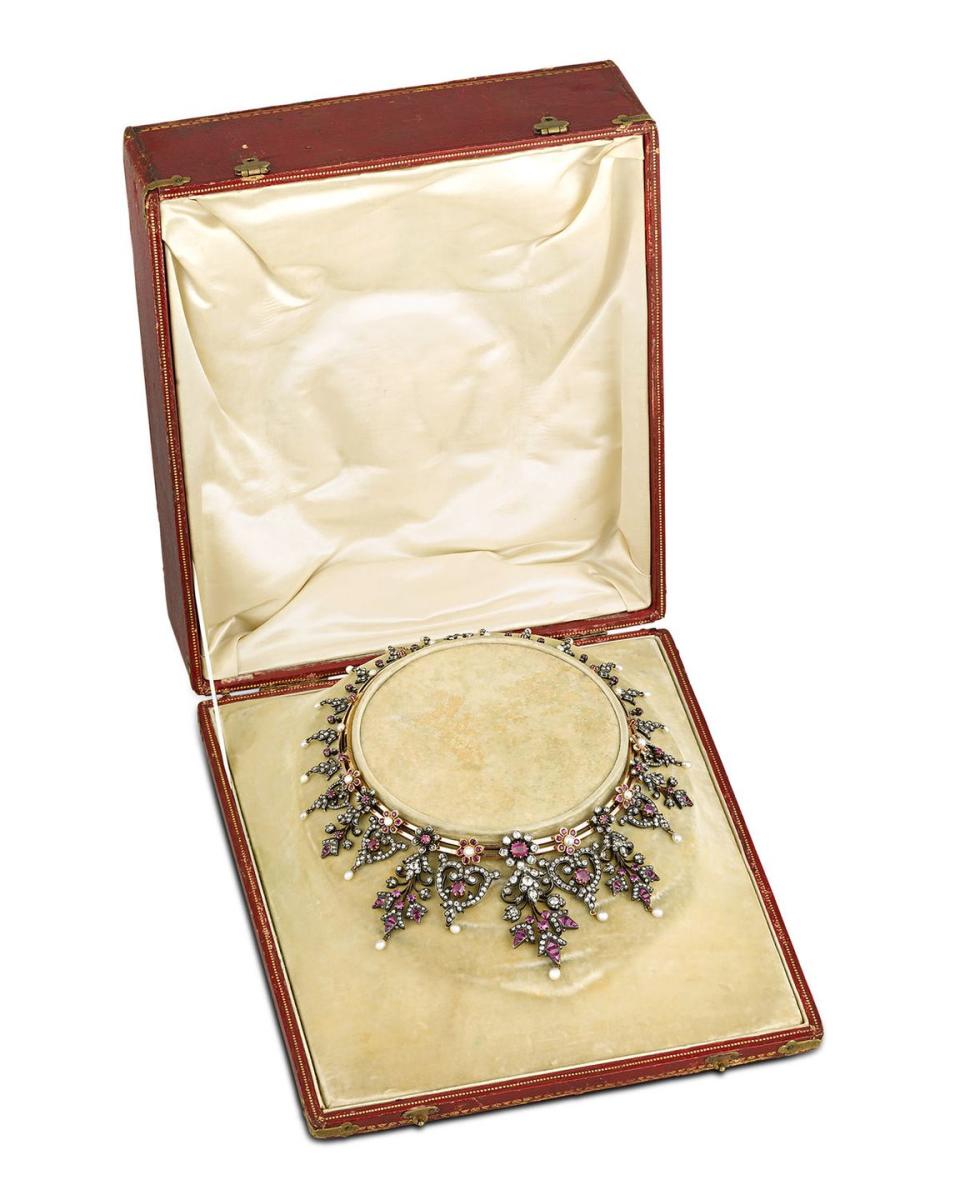You Can Own One of the French Crown Jewels
In 1887, the French crown jewels were publicly sold to the highest bidders in what was regarded as the auction of the century. Exquisite ruby, emerald, and diamond jewels and tiaras that were worn by kings, queens, and empresses were sold by the newly elected Third Republic. The infamous sale was fueled by the government’s fear that royalists might stage a coup, but they reasoned that without a crown, there could not be a King.
One of those magnificent French crown jewels has resurfaced at M.S. Rau, the New Orleans-based art and antiques dealer. It’s a necklace set with rare Burmese rubies, old-mine cut diamonds, and natural pearls that was crafted circa 1830 and remains in perfect condition. The price tag for a piece of wearable history is $375,000. “There may never be another opportunity to own one of the French crown jewels,” says Bill Rau, the company’s president. He recently acquired the jewel from an elderly couple in Geneva and he doesn’t know of any other French crown jewels that remain in private hands today.
Even without the extraordinary provenance, he says the necklace is exceptional. “The Burmese rubies literally glow like hot coals,” says Rau. It’s also remarkably flowing and flexible and lays beautifully around the neck because each tassel is separately hinged.
What really happened to the hundreds of French royal jewels that were sold in 1887.
Rau says that if the French crown jewels hadn’t been dismantled and sold, they would likely have been the greatest royal jewelry collection in the world, even surpassing the famous British crown jewels. That’s because France was harbinger of great taste, and fashionable French royals like Marie Antoinette and Empress Eugénie, wife of Napoleon III, commissioned exquisite designs from the great French jewelry houses. Each generation of extravagant kings and queens added to the jewelry coffers.

The infamous sale of 1887 ignited great debates among the warring French royalists and government and was even described as “historical vandalism,” but the sale was monumental for Tiffany & Co. It’s owner Charles Tiffany personally attended the Paris auction and acquired one-third of the pieces. When he returned to New York with his historic loot, he put on a jewelry show the likes of which had never been seen before. He had custom leather boxes made for each jewel and embossed them with the royal coats of arms and Diamants de la Couronne (crown jewels) in 24-karat gold on top, and Tiffany & Co. New York and Paris inside. The line to view the jewelry stretched for three blocks, and anyone who could afford it wanted a jewel with a European royal provenance.
“That single event propelled Tiffany from a jewelry store to the most famous luxury emporium in the western hemisphere,” explained Rau.
Over the years only a few of the French crown jewels have reappeared. In 2017, the famous Grand Mazarin diamond, a 19.07-carat light pink from the Golconda mines, sold at Christie’s in Geneva for over $14 million.
The French have tried to acquire the Crown Jewels when on the rare occasion they appear. One of those pieces was the diamond bow brooch made for Empress Eugénie by François Kramer in 1855. It was sold at the 1887 auction for 42,000 francs to the jeweler Emile Schlesinger, who acquired it for Caroline Schermerhorn Astor, the doyenne of New York society. After changing hands at least once, it was sold in 2008 to the Friends of the Louvre for a reported $11 million.
What’s the price of history?
How do you determine the value of an exceptionally rare historical jewel, without any comparable? “The reality is that there is no price for something like this,” says Rau. A jewel that is this rare, and bears a provenance this good, could command almost any price.
An example of this is when Rau sold the only painting that Winston Churchill created during World War II in 2011. The buyer was Brad Pitt, who gifted it to his then-wife Angelina Jolie. A few years later, she sold it at auction for $11.5 million, five times the amount that Pitt paid.
“It’s rare when history, beauty and quality come together in one piece like this necklace,” says Rau. “This is wearable history.”
You Might Also Like

